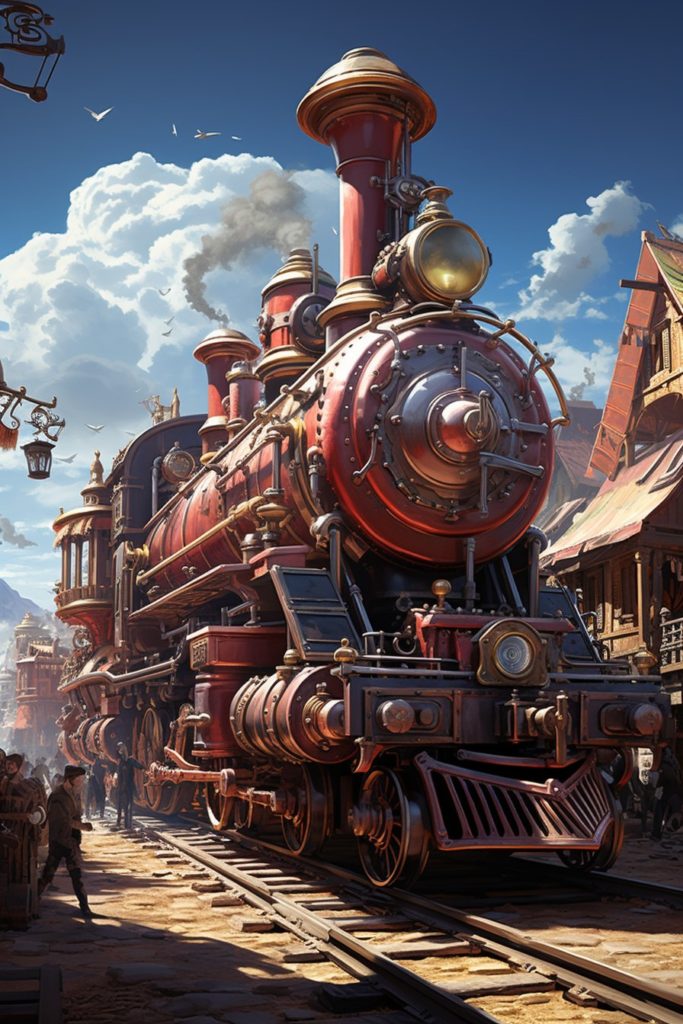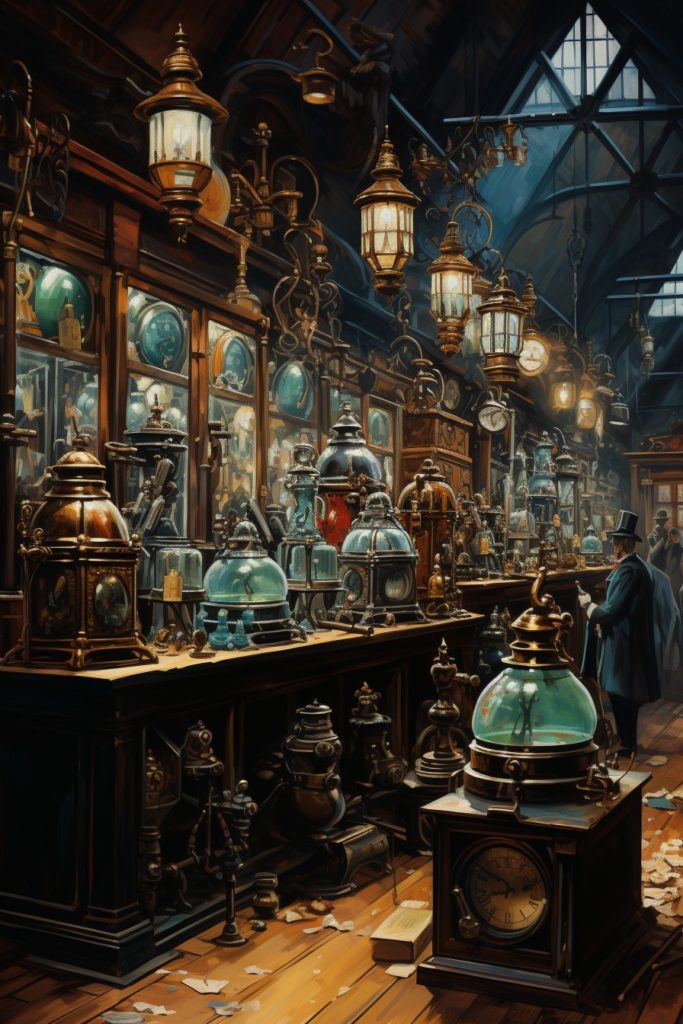
 The Steampunk genre takes the historical elements of the Victorian era and fuses them with imaginative and speculative technology. From fantastical airships to steam-powered mechanical beasts, this intriguing genre evokes a sense of nostalgia while inspiring dreams of a retro-futuristic world. This fusion creates an atmosphere that’s both antiquated and advanced, offering endless possibilities for storytelling and world-building. For fans of my own steampunk world, the Creedverse, the infusion of Wild West elements into the steampunk aesthetic offers an additional layer of complexity and imagination.
The Steampunk genre takes the historical elements of the Victorian era and fuses them with imaginative and speculative technology. From fantastical airships to steam-powered mechanical beasts, this intriguing genre evokes a sense of nostalgia while inspiring dreams of a retro-futuristic world. This fusion creates an atmosphere that’s both antiquated and advanced, offering endless possibilities for storytelling and world-building. For fans of my own steampunk world, the Creedverse, the infusion of Wild West elements into the steampunk aesthetic offers an additional layer of complexity and imagination.
I’m Jonathan Fesmire, author of The Adventures of Bodacious Creed, a weird west trilogy that includes the novels, Bodacous Creed: a Steampunk Zombie Western, Bodacious Creed and the Jade Lake, and Bodacious Creed and the San Francisco Syndicate, which take place in my fictional rality, the Creedverse.
It’s important to remember that Victorian era doesn’t necessarily mean Victorian England. In a steampunk world, the technology of the time would be all over the world. As an American, and someone interested in the history of Wild West, that setting in an alternate timeline is what I most love to explore in my fiction. Today, let’s talk about steampunk and retrofurutistic technology, shall we?
Steampunk and Retrofuturistic Technology
The central technological element in any steampunk story is, unsurprisingly, steam power. Steam engines revolutionized transportation, manufacturing, and even helped in the advancement of computational devices. Steam power relies on boiling water to produce steam, which then pushes pistons or turns turbines to generate mechanical energy. This foundational technology set the stage for industrial revolutions and drastically changed human societies. In the Creedverse, steam power not only coexists with the Wild West setting–referred to in the genre as “Weird West”–but also fuels innovative machines that extend far beyond traditional historical boundaries.

Airships and Flying Machines
If you’ve ever dreamed of sailing through the skies, you can live vicariously through steampunk literature. Airships are a common trope in these stories, typically resembling zeppelins or dirigibles but outfitted with gears, cogs, and sometimes even weaponry. They serve as both military and civilian vessels, much like the naval ships of yore. These airships capture the spirit of adventure and exploration, serving as a symbol of human ingenuity. Additionally, the steampunk versions often feature advanced navigational tools and defensive mechanisms, creating a sense of evolved technology. I haven’t played with airships in my world, but I enjoy them when they appear in other authors’ stories.
Mechanical Automatons
 Human-like automatons and mechanical animals have fascinated people since ancient times, but it was in the Victorian era when these ideas started to become more technically feasible. Most of these historical automata were operated by clockwork mechanisms. However, the steampunk genre often imagines more complex and functional beings powered by steam or other, more fantastical, sources of energy. These mechanical creatures often possess human-like traits, adding a layer of emotional complexity to the genre. In the Creedverse, auto sapients are not just mindless tools but come equipped with specialized functionalities that allow them to interact dynamically with their environment.
Human-like automatons and mechanical animals have fascinated people since ancient times, but it was in the Victorian era when these ideas started to become more technically feasible. Most of these historical automata were operated by clockwork mechanisms. However, the steampunk genre often imagines more complex and functional beings powered by steam or other, more fantastical, sources of energy. These mechanical creatures often possess human-like traits, adding a layer of emotional complexity to the genre. In the Creedverse, auto sapients are not just mindless tools but come equipped with specialized functionalities that allow them to interact dynamically with their environment.
In the Creedverse, auto sapients elevate the concept of automatons to an entirely new level–or, at least, I like to think so!. They are capable of complex tasks and are imbued with an array of functions that push the boundaries of what one might expect from technology in the late 19th century. Using steam power, ether power, and advanced mechanical engineering, they perform specialized jobs, including medical procedures, with astonishing precision. This has opened up exciting narrative possibilities, as these creations can become central figures in various story arcs, displaying traits and abilities that blur the line between machine and sentient being. For example, my protagonist, James Creed, has an auto sapient (oh yes, they’re colloquially called “steelies”) called Ludwig who prepares meals and helps guard his home. His daughter, Anna Boyd, has three auto sapient steelies, two that protect her establishment, and one that helps her in her laboratory. The aforementioned Atwood clinic has a steely called Bishop that assists with medical procedures.
In a world where steam-driven tech and the Wild West converge, auto sapients symbolize the essence of the Creedverse, representing an amalgamation of history, technology, and limitless imagination.
Retrofuturistic Medical Advances
Medicine is another area where steampunk fiction often diverges sharply from historical reality. The Creedverse, for example, boasts advanced medical practices and surgical techniques that we would classify as modern. Establishments like the Atwood Clinic in my fictional version of Santa Cruz, California, exemplify this melding of Victorian aesthetics with futuristic technology. These medical advances reflect the genre’s ability to challenge historical constraints, envisioning a world where technological progress is not bound by time. Moreover, it explores ethical considerations tied to advanced medicine, such as the social implications of these new techniques. (The Atwood Clinic is mentioned in Bodacious Creed: a Steampunk Zombie Western, though not by name, and will probably appear in my upcoming novel, Anna, Daughter of Creed.)

Energy Sources and Sustainability

In addition to steam power, steampunk often explores alternative energy sources like aether, solar power, and sometimes even magic. These can be seen as commentary on our current environmental challenges or as an imaginative exercise in “what if?” While some of these alternative energies may seem like pure fantasy, they can open conversations about renewable and sustainable energy sources in our own world. Steampunk serves as a backdrop to explore these complex themes, acting as both a mirror and a lens through which we can examine real-world issues.
Closing Thoughts
 From steam-powered mechanical beasts to advanced medical clinics, the science behind steampunk is a fascinating blend of the historically plausible and the creatively speculative. It draws us into worlds both familiar and exotic, offering a unique lens through which to examine our own technological achievements and aspirations. It also presents an intriguing paradox, blending the antique with the futuristic in ways that challenge our perceptions of progress and possibility. For fans of the Creedverse, this blend of Wild West and steampunk elements, exemplified by inventions like auto sapients, adds a unique flavor to the genre while pushing the boundaries of what we traditionally view as possible in a historical setting.
From steam-powered mechanical beasts to advanced medical clinics, the science behind steampunk is a fascinating blend of the historically plausible and the creatively speculative. It draws us into worlds both familiar and exotic, offering a unique lens through which to examine our own technological achievements and aspirations. It also presents an intriguing paradox, blending the antique with the futuristic in ways that challenge our perceptions of progress and possibility. For fans of the Creedverse, this blend of Wild West and steampunk elements, exemplified by inventions like auto sapients, adds a unique flavor to the genre while pushing the boundaries of what we traditionally view as possible in a historical setting.
The next time you find yourself immersed in a steampunk narrative, take a moment to appreciate not only the complex tapestry of science, technology, and imagination that makes these worlds come alive but also the themes of exploration and discovery that run through them. Whether or not the science is realistic, the sense of wonder and possibility it evokes is a crucial part of what makes steampunk—and its many sub-genres, including the Creedverse—so engaging.
If you’re interested in my steampunk zombie western trilogy, The Adventures of Bodacious Creed, just click the link! You can also click one of the short story images in the sidebar to get a Creedverse story for free.
“Innovation is the ability to see change as an opportunity–not a threat.” ~ Steve Jobs